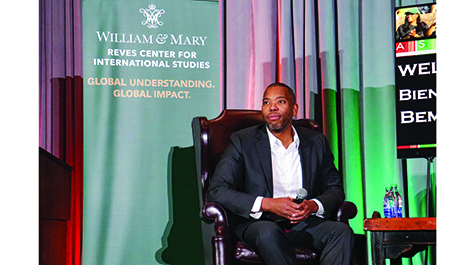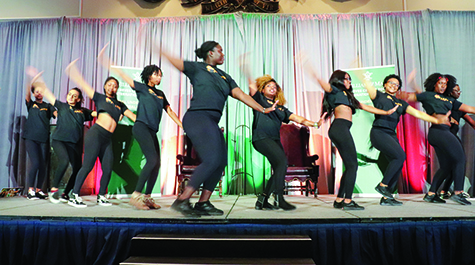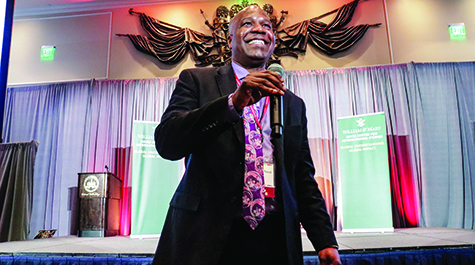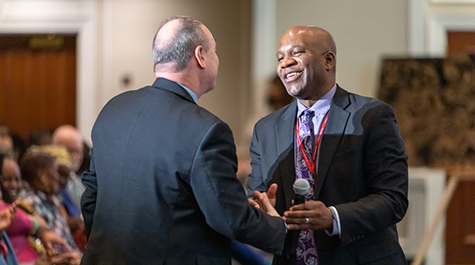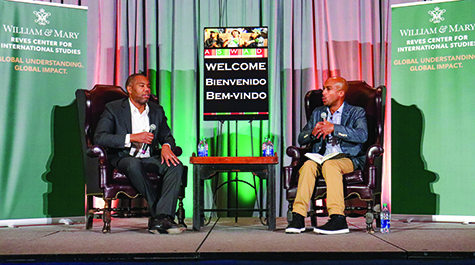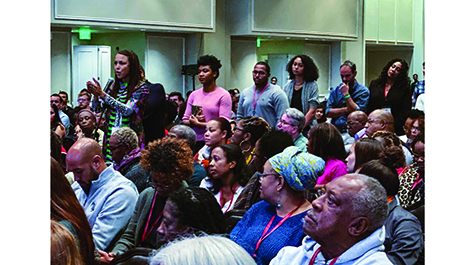Ta-Nehisi Coates delivers ASWAD keynote address
by Paulina Farley-Kuzmina ‘20
In the shadow of the 400th year of 1619, that marked the beginning of enslavement in British North America, William & Mary had the honor of hosting the 10th Biennial Conference for the Association for the Study of the Worldwide African Diaspora (ASWAD) at the Williamsburg Lodge.
The ASWAD conference, “Remembrance, Renaissance, Revolution: The Meaning of Freedom in the African World Over Time and Space,” ran from Nov. 5–9 and brought to Williamsburg nearly 1,000 international scholars, activists, and artists from more than 30 countries to explore the ways in which African people around the world have fought against oppression and created new cultures and identities. Robert Trent Vinson, incoming president of ASWAD and Frances L. and Edwin L. Cummings Professor of History and Africana Studies at William & Mary, had worked tirelessly for over two years, first, to bring the conference to William & Mary (besting competitors such as Emory University); and then, in collaboration with colleagues and conference coordinator Chadra Pittman, to craft a powerful and compelling conference.
Vinson’s guiding influence was felt throughout the week in its panel discussions, African and African Diaspora film festival, and artistic performances by guest artists and W&M faculty, but nowhere was it more evident than at the keynote address on Friday, November 8 at the Williamsburg Lodge.
In front of a standing-room-only audience, including President Katherine Rowe, Vinson opened the event by explaining that the keynote would not be a lecture, but actually a discussion between two friends and classmates from his days as a student at Howard University: journalist, intellectual and author Ta-Nehisi Coates and professor of history at Temple University, Ben Talton. Vinson also explained that the keynote was also special because it was both an ASWAD and William & Mary event, as it was also the 2019 George Tayloe Ross Lecture on International Peace, an annual lecture presented by the Reves Center for International Studies. He then thanked Stephen Hanson, Vice Provost for International Affairs and Director of the Reves Center for his steadfast support of the conference and invited Hanson to deliver the formal introduction of Coates and Talton.
Vice Provost Hanson emphasized that to host the ASWAD conference was a huge honor for William & Mary, and particularly important for the university due its own long historical associations with slavery and Jim Crow segregation. He noted Coates’s manifold intellectual and artistic contributions to America and the world, and thanked both Coates and Talton for their kind generosity in sharing their insights with ASWAD and the William & Mary community.
The easy give and take between Coates and Talton was as genuinely heartfelt as it was salient. The loosely structured discussion touched on a variety of topics, such as Coates’ process of writing his first novel, The Water Dancer, his experiences at a Historically Black College/University (HBCU), and the relationship between journalism and activism.
Talton also asked Coates about his recent absence from social media and the consequences of his rise to fame. “It never occurred to me how much of an audience [my Twitter feed] would actually have,” Coates explained. “But then when it became a ‘thing’ it changed the interactions I had with people. I was frustrated with this persona and what people thought of me before I said anything. My wife has this saying: ‘You never want to be bigger than the sound.’ And I was becoming bigger than the sound.”
Although The Water Dancer is perhaps technically considered a work of fiction, Coates described the extensive research that went into his portrayal of slavery in the pre-Civil War Antebellum South to make the work as historically accurate as possible. Coates describes not only using scholarly sources, but also seeking out as many primary sources as possible to embody the intricate details of what life as a slave for his protagonist Hiram would have been like.
“It was always the primary sources that got me, and I always sought them out to the extent that I could,” Coates said. “Historians sometimes have a tendency to linger, even leer, at some of the more visceral details; the whippings, the rape. All of that happened and people should know, I’m not arguing about hiding that. But there is a way that we can use our lenses and our cameras not to linger on these scenes of brutality and raise the identity of the people.”
Talton then connected the importance of fiction to better understand people’s contextual circumstances. “In a sense, we are using fiction to fill in the holes that are left, using fiction to get at that history,” Talton chimed in. “I remember when I was in college and a friend of mine and I got in a car and drove south. We said that we were looking for slaves. Anytime we saw a plantation we pulled off and tried to imagine what it was like to be there.”
Talton, with some playful protest from Coates, asked Coates to read a few passages of his novel out loud. Coates’ captivating voice and masterful prose echoed through the auditorium, the audience hanging onto his every word as he gave voice to his characters. “The people become human. They don’t just become people something happened to. They don’t just become slaves, they become people who were actual human people,” said Coates. “You can restore that kind of humanity [in a novel].”
His detail and dedication to the truth have distinguished Coates as a journalist. During his time as a writer for The Atlantic, Coates recalls having the ability to learn extensively about his topics of interest, which is what led him to explore and ultimately become one of the leading proponents of reparations. “There was a lot of time to read, there was a lot of time to engage with people. I had someone who was actually paying me to write these deeply researched articles. It was a time of tremendous growth for me,” said Coates.
Although Coates is an important figure with influential work, especially in activist spaces, he is quick to clarify his role as a writer and distinguish between the goals and methods inherent of activism and journalism. “I pride myself on my journalism and my journalistic work and I’m very careful about stepping into the territory of activism,” said Coates. “Writing is activism though,” countered Talton.
Later on in the conversation the topic resurfaced. “I came into this as a journalist and we’re schooled a certain way on how to approach and think about things,” Coates said. “I think it’s important for me to occupy a certain lane. I think I need distance to see.”
Throughout the discussion, both Coates and Talton often acknowledged the role their educational institutions and other scholarly work has played in shaping their perspectives and their work. In particular, they focused on the importance of HBCUs in cultivating their communities and learning.
“People always say if you go to an HBCU you’re not in the real world; they’re not preparing you to deal with the real world. But what they’re really saying is it must be inferior because it’s black,” Talton said. “Look at all of the people that came from HBCUs and the network that you have there.”
After the presentation concluded, Coates answered a handful of questions from audience members, including international scholars, local community members, and William & Mary faculty and students.
“First I just want to say how honored I am to share this space with you. I have yet to find another author who has brought me such joy and understanding in each one of his books, so thank you,” began Maya Farr-Henderson, a senior sociology major at William & Mary. “You talk about this concept of ‘Mecca’ and how you found Howard to be so transformative in your experience, and I was wondering if you have any other advice for finding your own Mecca and once you arrive, how do you receive that education, how do you recognize it?”
“You join ASWAD,” Talton joked, to the delight of his audience.
“I get that question a lot when I go to white schools,” said Coates. “It’s tough because I was never in that situation. I think your organizations and your community become that much more important, and that was not something I had to do much of when I was your age.”
One audience member, who identified herself as a professor and ASWAD member, thanked Coates for his work and the stimulating discussion, and asked if he could tell them some of the professors who had nurtured his love of lifelong learning.
“We were at the history department at Howard at a great time,” Coates responded. Talton and Coates excitedly started naming faculty they remembered. They interrupted each other as they recalled the men and women who had influenced them.
“To be eighteen, nineteen, twenty years old and to have that on a regular basis and then to have people to go outside class and talk about it...I wouldn’t be here without that,” said Coates.
 Skip to main content
Skip to main content

